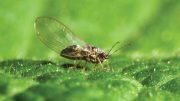Posted on: July 29, 2016 by Amy Carroll
Last week we reported on a sharp increase in the prevalence of Lso-positive psyllids relative to the previous weeks this season. Out of an abundance of caution to avoid reporting any false positives, we re-tested a subset of those positive psyllids and we stand by our original results. The sites during Week 9 with putative positive psyllids that we had labelled as “pending” are now labelled as “positive.”
In addition, several potato psyllids collected last week tested positive for Lso (liberibacter), the bacterium that causes zebra chip. Lso-positive psyllids were found in the following counties: Payette (1 field), Owyhee (1 field), Canyon (6 fields), Twin Falls (2 fields), Minidoka (2 fields), and Cassia (1 field). Furthermore, two potato psyllid nymphs collected from leaf samples from a field in Ada County tested positive for Lso.
Potato psyllids were collected this week on sticky traps in potato in the following counties: Malheur (OR) (1 field), Payette (3 fields), Owyhee (5 fields), Canyon (13 fields), Ada (2 fields), Elmore (2 fields), Twin Falls (8 fields), Jerome (2 fields), Cassia (2 fields), and Power (1). Additionally, potato psyllid nymphs were captured on leaf samples from 2 fields in Ada County, and two potato psyllids were captured from vacuum samples taken from Intense fields in Canyon and Ada County.
We collected 361 psyllids this week from sticky cards (246 from Light sites and 115 from Intense sites). Of the total 363 psyllids captured this week, 335 came from the Treasure Valley. We found psyllids in 40 of the 101 fields (40%) that were sampled this week.
Because of the recent prevalence of Lso and the relatively high numbers of potato psyllids that we have been collecting each week, we urge growers to maintain their IPM programs targeting psyllids and to be on the lookout for plants exhibiting ZC symptoms over the coming weeks. Foliar symptoms should be manifested about three weeks following inoculation, but will need to be confirmed by examining and testing tubers. See link below for description and photos of ZC symptoms, and please take suspicious plant samples to the Kimberly R&E Center or to your local UI Extension Center.
http://oregonstate.edu/dept/hermiston/sites/default/files/pnw633_0.pdf
SOURCE: Pacific Northwest Pest Alert Network


